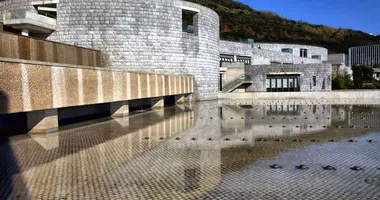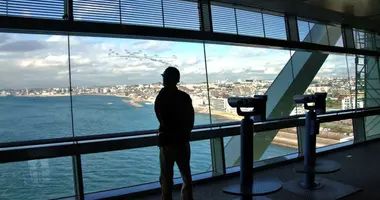Awaji Island 淡路島
- Published on : 06/11/2020
- by : SR
- Youtube
Awaji island (Awaji-shima) in Japan's Inland Sea is linked to Honshu island via the Akashi Kaikyo Ohashi Bridge, and to Shikoku island via the Naruto Ohashi Bridge. Referenced in ancient Japanese lore, its 393km² area contains all the country has to offer for visitors to enjoy: hot springs, temples and shrines, impressive landscapes, sandy beaches, artistic traditions, pop culture attractions, and culinary delights.
Awaji has changed significantly since the opening of the Akashi Straits Suspension Bridge (Akashi Kaikyo Ohashi) which connects Hyogo Prefecture to Awaji Island. The Akashi Kaikyo Ohashi, which opened in 1998, has the longest central span of any suspension bridge in the world, at 1,991m (6,532 ft).
For those visitors interested in the building of the bridge, the Bridge Exhibition Center (Hashinokakagakukan) near Maiko Station on Honshu, southwest of Kobe, has information on its construction. There are also tours of the bridge available for those who book online in advance. Nearby is also the Sun Yat-Sen Museum in Maiko Park, housed in an early 20th-century residence moved here when the bridge was constructed.
Over on Awaji Island itself on the north-west coast in the village of Hokudan is the Hokudan Earthquake Memorial Park, which was the epicenter of the 1995 earthquake that devastated Kobe. Part of the 10 km fault line can still be seen.
Things to see and do in Awaji
Awaji is known for its beautiful flowers in season, onion cultivation, incense, some fine beaches on both the east and west coasts, and its ancient burial mounds, or kofun. Recently, it has become something of a mecca for cyclists who can travel around the island in a couple of days.
The best beaches on Awajishima are the sandy Ohama Beach on the east coast and Goshiki Beach on the east coast, which is pebbled but enjoys spectacular sunsets. There are a number of hotels close to both these beaches.
Godzilla Attraction
The Godzilla Interception Operation attraction opened in 2020. The fun attraction consists of several different areas. Included are the world's largest Godzilla statue, with a total length of around 120 meters, the world's first permanent Godzilla Museum, a zipline, a theater, and an interactive shooter game. In addition, the restaurant serves a Godzilla-inspired menu, and there's a Godzilla shop, too. The attraction is an absolute must for fans of Japan's most famous monster.
Temples & Shrines
Awaji has several temples and shrines worth a visit. World Peace Kannon at 80 meters in height, was once one of the tallest statues in the world but has fallen into disrepair and is virtually abandoned. North-east of the island is Honpukuji Temple, situated on the top of a hill. The temple faces Osaka Bay. This former temple of the Shingon esoteric school of Buddhism, dedicated to Yakushi Buddha, was renovated in 1991. The main building of the temple is Tadao Ando's Water Temple, or Mizumido, is a striking modernist building. The circular concrete building has a lotus-filled pond for its roof, and the temple interior is entered down a curved stairway.
Iwagami Shrine (岩神神社) and Izanagi Shrine (伊弉諾神宮) are located close to each other in the north-western part of the island. Izanagi Shrine is connected with the creation myths of Japan, which have Awaji as the birthplace of Japan. It is the most important shrine on the island. Izanagi Shrine's spacious grounds are popular with locals for the important festivals of the Japanese year, such as O-shogatsu (New Year) and Shichi-go-san.
The smaller Iwagami Shrine is dedicated to a cluster of holy rocks, hence the name of the shrine, which can be loosely translated as "rock or boulder god" shrine. The main hall, or honden dates from the 16th century, and the impressive rocks have been viewed since Heian times.
Senzan Senkoji Temple, dedicated to Kannon, the Bodhisattva of Compassion, is found at the island's highest point, on Mount Senzan. From here, you have a splendid view of a string of islands and islets in the Inland Sea and the mountains of Shikoku Island.
Puppet Theater
Awaji is the home of ningyo joruri puppet theater, which is a forerunner of bunraku. The Awaji Joruri Puppet Theater in Fukura, in the south of the island, offers short performances of this over 500-year-old art.
Yumebutai
The Awaji Yumebutai (Awaji Island Project) was designed by famous architect Tadao Ando to reuse the site from which earth was extracted for the construction of Kansai International Airport (KIX).
The site includes beautiful gardens, walking trails, and Japan's biggest greenhouse. Another Ando building on Awaji is the modernist Water Temple (Shingonshu Honpukuji; 本福寺) constructed in 1991, a beautiful space constructed with pools and concrete walls.
- Read more about : Awaji Yumebutai
Sumoto Castle
There is an onsen (hot spring) in Sumoto with both indoor and outdoor baths. A number of resort-style hotels are located here, along with Sumoto Castle which was rebuilt in 1928 after the original Edo Period building had been demolished in the 1630's. The Awajishima Museum, at the base of the castle, is dedicated to the history and culture of the island. It has displays on local festivals, puppet theater, and the art of local painter Tamao Naohara.
Matsuho-no-yu is a hot spring in the north of the island with views of the Akashi Kaikyo Ohashi from its outdoor baths.
The Awaji World Park Onokoro is an amusement park just south of Awaji City with a number of world sights such as the Taj Mahal, Leaning Tower of Pisa, Wat Arun, the Colosseum, and the Parthenon, all built at 4% of their original size.
Naruto Whirlpool
What makes the island most famous are the Naruto whirlpools, located in the south, in the Naruto Strait. These whirlpools are caused by tidal movements between the Inland Sea and the Pacific Ocean. The currents can reach 20 kilometers per hour! From the southern port of Fukura, there are daily cruises to see the Naruto Whirlpools and the Naruto Ohashi Bridge (2000 yen). Or they can be seen from the port. The best time to see them is usually one hour before or after the start point of the tide, which takes place four times a day. Close to the whirlpools, the Uzushio Science Museum explains the phenomenon of whirlpools through a 3D cinema and other presentations.
Hello Kitty Appleland
Hello Kitty Appleland is an attraction dedicated fully to the internationally beloved Hello Kitty franchise from Sanrio. Enjoy Hello Kitty Smile. This multi-media center features art installations, a 360-degree theater, restaurants, gift shops, and Hello Kitty mascots out and about to greet guests. Nearby, Hello Kitty Applehouse features a signature 360-degree theater and even an observation deck to enjoy the surrounding beauty of Awaji Island. Both fans of the Hello Kitty franchise as well as those with an appreciation for modern art and installations ought to visit during their time on Awaji!
Our recommendations off the beaten track:
Where to eat :
- Seikaiha Aonoya:
Specializing in sushi and tempura, this prestigious restaurant offers a unique dining experience in an extraordinary setting. Located on Awaji's picturesque Sunset Line, visitors take seats in an amphitheater with a bird's-eye view of the sea through the large picture windows, but also of the chef preparing the dishes in front of the diners. At Aonoya, the signature summer gourmet dish, “Hamo Gozen” is highly recommended !
For a Zen experience:
- Zenbo Seinei:
This architecturally unique building made entirely of wood, mainly Japanese cedar, offers a timeless experience of relaxation. At one with the surrounding Japanese nature, Zenbo Seinei immerses us in a peaceful atmosphere. The concept is to experience a Zen retreat for one or two days. The program includes meditation in beautifully designed spaces, vegan Zenbo cuisine prepared by a renowned chef, Zen tea ceremony and Zen calligraphy workshops, all designed to help you reconnect with your true self.
How to get to Awaji
- By Air
Kobe Airport is the nearest airport to Awaji Island and has flights to Ibaraki, Ishigaki, Kagoshima, Naha (Okinawa), Nagasaki, Sapporo, and Tokyo (Haneda). Kobe Airport is located on an artificial island just south of Port Island and connects to Sannomiya by Port Liner trains.
- By Train
JR Shinkansen bullet train stops at Shin-Kobe Station. About 1 km south of Shin-Kobe Station, Sannomiya Station is the main rail hub for intercity Hankyu, Hanshin and JR trains to Osaka and Kyoto. There are no trains on Awaji Island.
- By Ferry
There are direct ferry services to Iwaya on Awaji from Akashi Port, a short walk from JR Akashi Station. The Jenova ferry is a 13-minute crossing from Akashi to Iwaya. For adults the fare is 500 yen with an extra 220 yen fee for a bicycle.
The ferries run roughly every 20 minutes on weekdays, every 40 minutes on weekends.
The high-speed ferry service between Sumoto and Kansai International Airport (KIX) ceased in 2007.
- By Bus
There are Express Bus services from JR Shin-Kobe Station to Sumoto on Awaji (2 hours) and on to Tokushima on Shikoku.
Infrequent local buses around the island are provided by Awaji Kotsu. Hitch-hiking is a viable option if you get stuck.













































